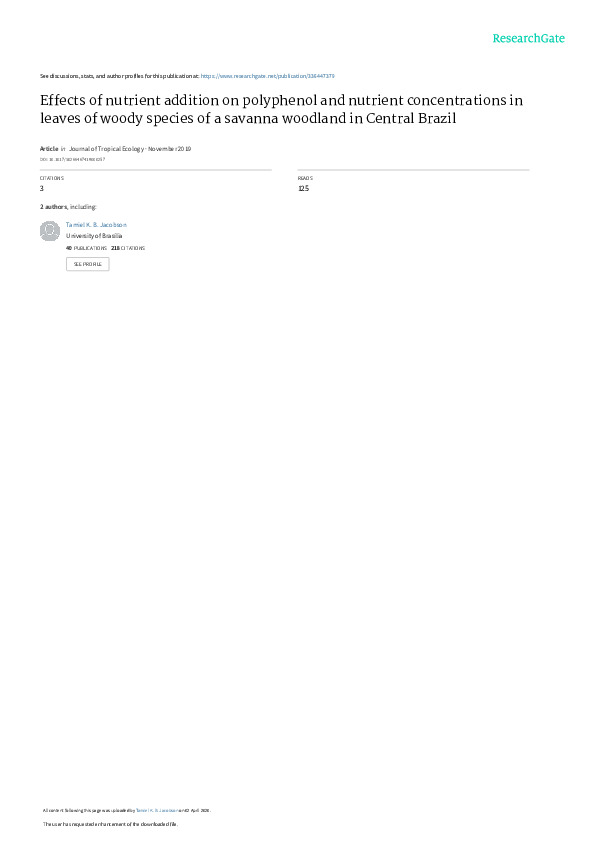Documento
-
effects_of_nutrient_addition_on_polyphenol_and_nutrient_concentrations_in_leaves_of_woody_species_of_a_savanna_woodland_in_central_brazilBaixar
Metadados
Título
Effects of nutrient addition on polyphenol and nutrient concentrations in leaves of woody species of a savanna woodland in Central Brazil
Descrição
We investigated whether changes in nutrient availability affected N, P, S and polyphenol concentrations in different leaf-development stages of three brevideciduous and three evergreen
dominant woody species in a nutrient-limited savanna woodland in Central Brazil.
Treatments included eight years of annual fertilization with 100 kg ha−1 of N, P, N plus P
and control, each replicated in four randomized 15 × 15-m plots. All species increased
S concentrations (minimum 28%) in young and mature leaves in fertilized plots. Dalbergia
miscolobium decreased total phenol concentrations with P (−34.3%, −23.7%) and NP fertilization (−28.2%, −17.1%). Blepharocalyx salicifolius increased total phenol (27.6%, 18.8%) and
tannin (46.3%; 43.5%) in P fertilized and increased total phenol (33.9%) and tannin (27.8%,
43.5%) in NP fertilized plots. Total phenol concentration decreased with leaf age in Ouratea
hexasperma, Styrax ferrugineus and Blepharocalyx salicifolius, which also decreased tannin
concentration with leaf age. For all treatments, brevideciduous species had higher N, P,
total phenols and tannin concentrations and lower S concentration than evergreens. These
differences between phenological groups suggest that tropical ecosystems responses to
environmental changes are more complex than anticipated by global vegetation models, with
consequences for predictions in ecosystem functions and resilience.
Tipo de documento
Artigo
Autor(es)
Tamiel Khan Baiocchi Jacobson | Mercedes Maria da Cunha Bustamante
Universidade
Cambridge University Press
Assunto
Biogeochemistry | Brazilian savanna | Eutrophication | Fertilization | Leaf age
Natureza do suporte
Versão eletrônica
Eixo temático
Taxonomia
Nome do periódico
Journal of Tropical Ecology
Ano
2018
Edição
6
Volume
35
Número de páginas
10
Idioma
Inglês
Acesso ao documento
Referência
Aerts R and Chapin FS (2000) The mineral nutrition of wild plants revisited: a re-evaluation of processes and patterns. Advances in Ecological Research 30, 1–67. Bieras AC and Sajo MDG (2009) Leaf structure of the cerrado (Brazilian savanna) woody plants. Trees – Structure and Function 23, 451–471. Bobbink R, Hicks K, Galloway J, Spranger T, Alkemade R, Ashmore M, Bustamante M, Cinderby S, Davidson E, Dentener F, Emmett B, Erisman JW, Fenn M, Gilliam F, Nordin A, Pardo L and De Vries W (2010) Global assessment of nitrogen deposition effects on terrestrial plant diversity : a synthesis. Ecological Applications 20, 30–59. Bryant JP, Chapin FS and Klein DR (1983) Carbon/nutrient balance of boreal plants in relation to vertebrate herbivory. Oikos 40, 357–368. Bustamante MMC, Medina E, Asner G, Nardoto GB and Garcia-Montiel DC (2006) Nitrogen cycling in tropical and temperate savannas. Biogeochemistry 79, 209–237. Bustamante MMC, Brito DQ, Kozovits AR, Luedemann G, Mello TRB, Siqueira Pinto A, Munhoz CBR and Takahashi FSC (2012) Effects of nutrient additions on plant biomass and diversity of the herbaceoussubshrub layer of a Brazilian savanna (Cerrado). Plant Ecology 213, 795–808. Chan KX, Wirtz M, Phua SY, Estavillo GM and Pogson BJ (2013) Balancing metabolites in drought: the sulfur assimilation conundrum. Trends in Plant Science 18, 18–29. Chapin FS (1995) New cog in the nitrogen cycle. Nature 377, 19–20. Coley PD, Bryant JP and Chapin FS (1985) Resource availability and plant antiherbivore defense. Science 230, 895–899. Covelo F and Gallardo A (2004) Green and senescent leaf phenolics showed spatial autocorrelation in a Quercus robur population in northwestern Spain. Plant and Soil 259, 267–276. Eiten G (1983) Classificação da vegetação do Brasil. CNPq, Brasília. 305 pp. EMBRAPA (1999) Manual de análises químicas de solos, plantas e fertilizantes. Embrapa, Brasília. 370 pp. Escarpa A and González M (2001) Approach to the content of total extractable phenolic compounds from different food samples by comparison of chromatographic and spectrophotometric methods. Analytica Chimica Acta 427, 119–127. Forrest GI and Bendall DS (1969) The distribution of polyphenols in the tea plant (Camellia sinensis L.). The Biochemical Journal 113, 741–755. Franco AC, Bustamante M, Caldas LS, Goldstein G, Meinzer FC, Kozovits AR, Rundel P and Coradin VTR (2005) Leaf functional traits of Neotropical savanna trees in relation to seasonal water deficit. Trees 19, 326–335. Françoso RD (2014) Padrões biogeográficos e composição das comunidades arb´oreas do Cerrado brasileiro. PhD thesis. University of Brasília, Brasília, Brasil. 159 pp. Françoso RD, Haidar RF and Machado RB (2016) Tree species of South America central savanna: endemism, marginal areas and the relationship with other biomes. Acta Botanica Brasilica 30, 1–9. Goldstein G, Meinzer FC, Bucci SJ, Scholz FG, Franco AC and Hoffmann WA (2008) Water economy of neotropical savanna trees: six paradigms revisited. Tree Physiology 28, 395–404. Gonçalves-Alvim SJ, Korndorf G and Fernandes GW (2006) Sclerophylly in Qualea parviflora (Vochysiaceae): influence of herbivory, mineral nutrients, and water status. Plant Ecology 187, 153–162. Gonçalves-Alvim SJ, Lana TC, Ranieri BD and Fernandes GW (2011) Test of hypotheses about herbivory and chemical defences of Qualea parviflora (Vochysiaceae) in Brazilian Cerrado. Revista Brasileira de Botânica 34, 223–230. Hagerman AE (2002) Tannin Chemistry Handbook. https://www.users. miamioh.edu/hagermae/. Hagerman AE and Butler LG (1978) Protein precipitation method for the quantitative determination of tannins. Journal of Agricultural and Food Chemistry 26, 809–812. Haridasan M (1992) Observations on soils, foliar nutrient concentrations and floristic composition of cerrado sensu stricto and cerradão communities in central Brazil. In Proctor J, Ratter JA and Furley PA (eds), Nature and Dynamics of Forest-savanna. London: Chapman & Hall, pp. 171–184. Haridasan M (1994) Solos do Distrito Federal. In Novais-Pinto M (ed.), Cerrado: caracterização, ocupação e perspectivas – o caso do Distrito Federal. Brasília: Editora da UnB/SEMATEC, pp. 321–344. Hättenschwiler S and Vitousek PM (2000) The role of polyphenols in terrestrial ecosystem nutrient cycling. Trends in Ecology and Evolution 15, 238–242. Hättenschwiler S, Hagerman AE and Vitousek PM (2003) Polyphenols in litter from tropical montane forests across a wide range in soil fertility. Biogeochemistry 64, 129–148. Hättenschwiler S, Tiunov AV and Scheu S (2005) Biodiversity and litter decomposition in terrestrial ecosystems. Annual Review of Ecology, Evolution, and Systematics 36, 191–218. Haukioja E, Ossipov V, Koricheva J, Honkanen T, Larsson S and Lempka K (1998) Biosynthetic origin of carbon-based secondary compounds: cause of variable responses of woody plants to fertilization? Chemoecology 8, 133–139. Herms DA and Mattson WJ (1992) The dilemma of plants: to grow or defend. Quarterly Review of Biology 67, 283–335. Jacobson TKB (2009) Composição, estrutura e funcionamento de um cerrado sentido restrito submetido a adição de nutrientes em médio prazo. PhD thesis. University of Brasília, Brasíla, Brasil. 172 pp. Jacobson TKB, Santos JGD, Duarte JB, Farias JG and Kliemann HJ (2005) Influência de fatores edáficos na produção de fen´ois totais e taninos de duas espécies de barbatimão. Pesquisa Agropecuária Tropical 35, 163–169. Jacobson TKB, Bustamante MMC and Kozovits AR (2011) Diversity of shrub tree layer, leaf litter decomposition and N release in a Brazilian cerrado under N, P and N plus P additions. Environmental Pollution 159, 2236–2242. Kozovits AR, Bustamante MMC, Garofalo CR, Bucci, S, Franco AC, Goldstein G and Meinzer FC (2007) Nutrient resorption and patterns of litter production and decomposition in a neotropical savanna. Functional Ecology 21, 1034–1043. Kraus TEC, Yu Z, Preston CM, Dahlgren RA and Zasoski RJ (2003) Linking chemical reactivity and protein precipitation to structural characteristics of foliar tannins. Journal of Chemical Ecology 29, 703–30. Kraus TEC, Zasoski RJ and Dahlgren RA (2004) Fertility and pH effects on polyphenol and condensed tannin concentrations in foliage and roots. Plant and Soil 262, 95–109. Lenza E and Klink CA (2006) Comportamento fenol´ogico de espécies lenhosas em um cerrado sentido restrito de Brasília, DF. Revista Brasileira de Botânica 29, 627–638. Lehmann CER, Archibald SA, Hoffmann WA and Bond WJ(2011) Deciphering the distribution of the savanna biome. New Phytologist 191, 197–209. McCulloch CE, Searle SR and Neuhaus JM (2008) Generalized, Linear, and Mixed Models. New York, NY: Wiley. 424 pp. McKee KL, Feller IC, Popp M and Wanek W (2002) Mangrove isotopic 15N and 13C fractionation accross a nitrogen vs. phosphorus limitation gradient. Ecology 83, 1065–1075.Montes R and Medina E (1977) Seasonal changes in nutrient content of leaves of savanna trees with different behaviour. Geo-Eco-Trop 4, 295–307. Myers N, Mittermeier RA, Mittermeier CG, Da Fonseca GAB and Kent J (2000) Biodiversity hotspots for conservation priorities. Nature 403, 853–858. Nardoto GB, Bustamante MMC, Pinto AS and Klink CA (2006) Nutrient use efficiency at ecosystem and species level in savanna areas of Central Brazil and impacts of fire. Journal of Tropical Ecology 22,191–201. Nitao JK, Zangerl AR and Berenbaum MR (2002) CNB: requiescat in pace? Oikos 98, 540–546. Northup RR, Dahlgren RA and Yu Z (1995a) Intraspecific variation of conifer phenolic concentration on a marine terrace soil acidity gradient; a new interpretation. Plant and Soil 171, 255–262. Northup RR, Yu Z, Dahlgren RA and Vogt K (1995b) Polyphenol control of nitrogen release from pine litter. Nature 377, 227–229. Northup R, Dahlgren R and McColl J (1998) Polyphenols as regulators of plant-litter-soil interactions in northern California’s pygmy forest: a positive feedback? Biogeochemistry 42, 189–220. Ratter JA, Bridgewater S and Ribeiro JF (2012) Analysis of the floristic composition of the Brazilian cerrado vegetation III: comparison of the woody vegetation of 376 areas. Edinburgh Journal of Botany 60, 57–109. Santos SC, Costa WF, Ribeiro JP, Guimarães DO, Ferri PH, Ferreira HD and Seraphin JC (2002) Tannin composition of barbatimão species. Fitoterapia 73, 292–299. Saraceno MI (2006) Efeitos da fertilização a longo prazo no metabolismo fotossintético, nas características foliares e no crescimento em árvores do Cerrado. MSc Dissertation, University of Brasília, Brasília, Brasil. 54 pp. Sarmiento G (1984) The Ecology of Neotropical Savannas. Cambridge, MA: Harvard University Press. 234 pp. Scholz FG, Bucci SJ, Goldstein G, Moreira MZ, Meinzer FC, Domec JC, Villalobos-Vega R, Franco AC and Miralles-Wilhelm F (2008) Biophysical and life-history determinants of hydraulic lift in neotropical savanna trees. Functional Ecology 22, 773–786. Sieh D, Watanabe M, Devers EA, Brueckner F, Hoefgen R and Krajinky F (2013) The arbuscular mycorrhizal symbiosis influences sulfur starvation responses of Medicago truncatula. New Phytologist 197, 606–616. Skidmore AK, Ferwerda JG, Mutanga O, Van Wieren SE, Peel M, Grant RC, Prins, HHT, Balcik FB and Venus V (2010) Forage quality of savannas – simultaneously mapping foliar protein and polyphenols for trees and grass using hyperspectral imagery. Remote Sensing of Environment 114, 64–72. Souza JP (2012) Ecological significance of leaf longevity of cerrado woody species. In Bezerra D and Ferreira TS (eds), Evergreens: Types, Ecology and Conservation. New York, NY: Nova Science Publishers, pp. 149–159. Sternberg LDS, Bucci S, Franco A, Goldstein G, Hoffman WA, Meinzer FC, Moreira MZ and Scholz F (2004) Long range lateral root activity by neotropical savanna trees. Plant and Soil 270, 169–178. Villar R and Merino J (2001) Comparison of leaf construction costs in woody species with differing leaf-spans in contrasting ecosystems. New Phytologist 151, 213–226. Wright DM, Jordan GJ, Lee WG, Duncan RP, Forsyth DM, Coomes DA (2010) Do leaves of plants on phosphorus-impoverished soils contain high concentrations of phenolic defence compounds? Functional Ecology 24, 52–61. Yu Z and Dahlgren RA (2000) Evaluation of methods for measuring polyphenols in conifer foliage. Journal of Chemical Ecology 26, 2119–2140. Zar JH (1999) Biostatistical Analysis. Englewood Cliffs, NJ: Prentice-Hall. 663 pp.

